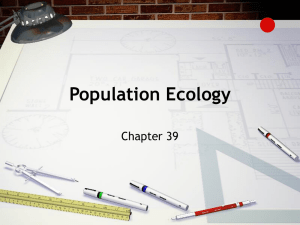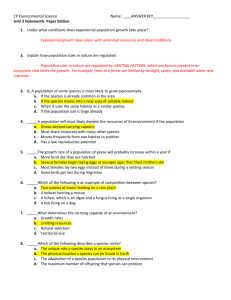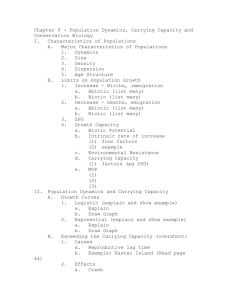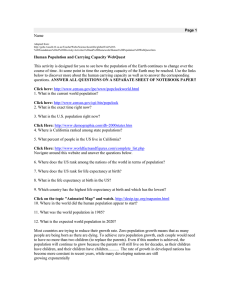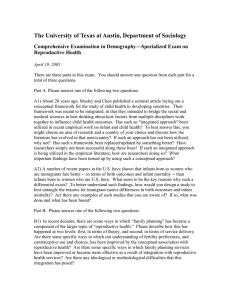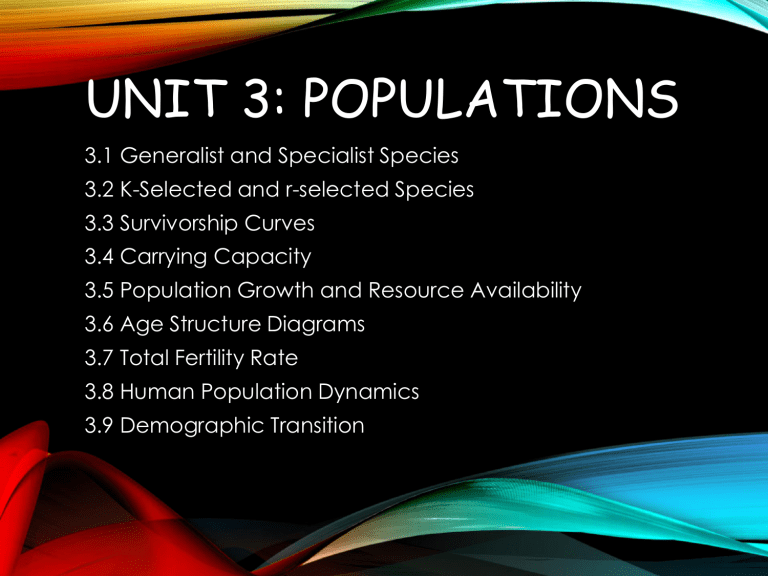
UNIT 3: POPULATIONS 3.1 Generalist and Specialist Species 3.2 K-Selected and r-selected Species 3.3 Survivorship Curves 3.4 Carrying Capacity 3.5 Population Growth and Resource Availability 3.6 Age Structure Diagrams 3.7 Total Fertility Rate 3.8 Human Population Dynamics 3.9 Demographic Transition GENERALIST VS. SPECIALIST • Generalists have broad niches: can survive over a wide range of conditions and changes in their environment (diet, climate, pH, light levels, etc.) • These species experience more competition, but make use of whatever is presented. • Specialists have narrow niches: can only live in a narrow range of conditions. • These species thrive when conditions are just right and are good competitors, but when conditions change, they don’t adapt easily. • Specialist species tend to be advantaged in habitats that remain constant, while generalists tend to be advantaged in habitats that are changing. EXAMPLES OF SPECIALISTS • Orchid mantis – a colorful mantis with appendages like leaves that thrives only on orchids in the tropics • Sword-billed hummingbird – has a beak longer than its body and has co-evolved with certain types of flowers its beak fits into and has difficulty getting food elsewhere • Koala – lives almost entirely on eucalyptus which is toxic to most other animals Orchid Mantis Sword-billed hummingbird Koala EXAMPLES OF GENERALISTS • Raccoon – has a wide diet, omnivore, lives in any area with trees, brush, or structures • Rat – found everywhere in the world except the Arctic; not picky eaters • Horseshoe crab – wide diet on sea floor bed, tolerates wide range of temperatures, can survive in low oxygen waters, and can ever be out of water for extended periods of time Raccoon Rat Horseshoe Crab • • • • POPULATION DYNAMICS – DEPENDS ON THE FOLLOWING FACTORS 1. Size (# of individuals) 2. Density (# of individuals in a certain space) 3. Dispersion (spatial pattern of individuals) 4. Age distributions (proportion of individuals by age in a population) • These may change in response to environmental stresses and changes in environmental conditions. WHAT GOVERNS POPULATION SIZE? • Births • Deaths • Immigration - # of individuals moving into a population • Emigration - # of individuals leaving a population • Population change = (births + immigration) (deaths + emigration) BIOTIC POTENTIAL • All populations vary in their ability to grow. • The intrinsic rate of increase or biotic potential (r) is the rate at which a population would grow if there were no limits on resources. • Organisms with high biotic potential tend to: • Reproduce early in life • Have short generation times (time between generations) • Reproduce many times • Have large numbers of offspring each time LIMITS ON BIOTIC POTENTIAL • No population can grow indefinitely! • There are limiting factors in the environment which put a halt to population growth (environment resistance). • The actual population size is determined by the relationship between the biotic potential and the environmental resistance. This is known as the carrying capacity (K) of an organism (the number of individuals of a species that can be sustained indefinitely in a given location) MINIMUM VIABLE POPULATION (MVP) • Typically the intrinsic rate of increase for a population requires a certain minimum population size be present. • If not • Individuals may not be able to find mates • Interbreeding may occur • Genetic diversity may be too low to allow for adaptations to environmental changes. EXPONENTIAL GROWTH • Populations with few resource limitations in the environment will grow exponentially. • The population size starts to grow slowly at first ant then grows faster as the population increases. • J shaped curve RESOURCE AVAILABILITY • Population growth is limited by environmental factors, especially by the available resources and space. • Resource availability and the total resource base are limited and finite over all scales of time. • When the resources needed by a population for growth are abundant, population growth usually accelerates. • When the resource base of a population shrinks, the increased potential for unequal distribution of resources will ultimately result increased mortality, decreased fecundity, or both, resulting in population growth declining to, or below, carrying capacity. LOGISTIC GROWTH CURVE • There is exponential growth when the population is small enough and hasn’t encountered significant environmental resistance, but the growth decelerates and levels off as it reaches the carrying capacity. • S shaped curve. EXCEEDING CARRYING CAPACITY • Sometimes a species will overshoot the carrying capacity. Typically because of a reproductive lag time. • This results in a dieback or crash in the population. • Carrying capacity is NOT a fixed value. POPULATION GROWTH AND DENSITY • Density independent population controls control the population regardless of the density of the population • Floods, fires, hurricanes, habitat destruction • Density dependent population controls - have a greater affect on the population as the density of the population increases • Competition, predation, parasitism, disease • Ex. Bubonic plague High density Low density POPULATION FLUCTUATIONS • Stable - population usually remains about the same • Irruptive - population size is maintained, but suddenly goes up and crashes back to a slightly lower level • Irregular - population size goes up and down for no known reason • Cyclic- population goes through regular increases and crashes over time. REPRODUCTIVE STRATEGIES • r-selected species or opportunists • Reproduce rapidly when conditions are favorable or when a disturbance opens up an new opportunity • Tend to be found in early stages of succession and are more successful when there are disturbances. • K-selected species or competitors • Do well in competitive situations when the population size is near the carrying capacity • Typically follow a logistic growth curve • May be more prone to extinction CHARACTERISTICS OF R STRATEGISTS • Many small offspring • • • • • Small adults Early age of reproduction Short generation times Little or no parental care Short lived • • • • • • • Most offspring die before reaching reproductive age Population fluctuates wildly around K Generalists Not competitive Adapted to changes in environmental conditions Early successional species High biotic potential CHARACTERISTICS OF K STRATEGISTS • Fewer, larger offspring • • • • • Larger adults Later reproductive age Longer generation times More parental care Longer lived • • • • • • • Most offspring survive to reproductive age Population fairly stable around K Specialists Competitive Better suited to stable environments Late succesional species Low biotic potential The availability of suitable habitat for individuals of a population in a particular area is what determines its ultimate population size. SURVIVORSHIP CURVES - SHOW THE NUMBER OF SURVIVORS OF EACH AGE GROUP FOR A PARTICULAR SPECIES • Late loss curves - most organisms survive through their reproductive years and die off later. Examples: most K strategists. • Early loss curves - most organisms die off before their reproductive years. Examples: most r strategists. • Constant loss curves - organisms die off at a fairly steady rate regardless of age. Examples: songbirds, lizards, and small mammals. LIFE TABLES • Show the numbers of individuals at each age from a survivorship curve. • Show the probable life expectancy at each age. • Life insurance companies rely on these to set prices. HUMAN POPULATION DYNAMICS FACTORS AFFECTING HUMAN POPULATION SIZE • Population change = (births+immigration) - (deaths + emigration) • Birth rate (crude birth rate) - the number of live births per 1000 people in a population per year. • Death rate (crude death rate) - the number of deaths per 1000 people in a population per year. • Annual rate of natural population change (%) = birth rate - death rate 10 • Rule of 70 (Doubling time) = 70 / (% increase) DEFINITIONS OF FERTILITY • Replacement level fertility - the number of children a couple must have to replace themselves. • 2.1 in developed countries • Up to 2.5 in developing countries • Total fertility rate - an estimate of the average number of children a woman will have during her reproductive years. TFR • This is affected by the age at which females have their first child, educational opportunities for females, access to family planning, and government acts and policies. • If the fertility rate is at replacement levels, then a population is considered to be fairly stable. • Factors associated with infant mortality rates include whether mothers have access to good healthcare and nutrition and changes in these factors can lead to changes in infant mortality rates over time. FACTORS AFFECTING BIRTH AND FERTILITY RATES • • • • • • • • • Importance of children to the workforce Urbanization Cost of raising and educating children Educational and employment opportunites for women Infant mortality rate Average age of marriage Availability of pensions Availability of legal abortions and birth control methods Religious beliefs, traditions, and cultures FACTORS AFFECTING DEATH RATES • Availability of food • Nutrition • Public health • Sanitation and personal hygiene • Safety of water supplies INDICATORS OF HEALTH • Life expectancy - average number of years a newborn can expect to live • Life expectancy has increased in developed and many developing countries • Life expectancy is dropping in the world’s poorest nations • Infant mortality rate - number of babies out of every 1000 born who die before their first birthday • Single most important indicator of a society’s quality of life • High infant mortality indicates • Undernutrition • Malnutrition • Infectious disease AGE STRUCTURE DIAGRAMS - SHOW THE PROPORTION OF A POPULATION BY SEX AT EACH AGE LEVEL • Age Categories • Prereproductive • Reproductive • Postreproductive • Types of Pyramids • Rapid growth • Guatemala, Nigeria, Saudi Arabia • Slow growth • U.S., Canada, Australia • Zero growth • Spain, Austria, Greece • Negative growth • Germany, Bulgaria, Sweeden POPULATION PYRAMIDS PROS AND CONS OF REDUCING BIRTHS • Opponents of slowing growth: • Life expectancy is longer than at any time in history • The world can still support billions more people • We are the world’s most valuable resource • Proponents of slowing growth: • If we do nothing, will cause more deaths • Cause more environmental harm DEMOGRAPHIC TRANSITION - AS COUNTRIES BECOME MORE INDUSTRIALIZED, FIRST THEIR DEATH RATES, AND THEN BIRTH RATES DECLINE • Preindustrial stage • Little population growth because conditions are harsh and birth rates and death rates are high • Transitional stage • Industrialization begins, food production and health care improve so death rates drop, but birth rates remain high • Industrial stage • Birth rates begin to drop and population growth slows • Postindustrial stage • Birth rates continue to decline until they equal or become less than death rates DEMOGRAPHIC TRAP • Rapid growth rate in developing countries could cause them to become stuck in stage 2 as rising population surpasses the ability of the country to provide for adequate healthcare and outweighs any economic benefits. • May cause countries to revert to stage 1. • Also resources available to today’s developing nations are not the same as those once available. WHAT CAN HELP REDUCE BIRTH RATES AND POPULATION SIZE? • Family planning programs • Empowering women • Economic incentives • Improved health care • Access to education • Eradicating poverty • Greater involvement of men in childrearing and birth control • Reduction of unsustainable use of resources CASE STUDIES THAILAND • Adopted policy in 1971 to reduce population growth. (Growth rate 3.2% and avg. of 6.4 children by 2002 growth rate 0.8% and 1.8 kids) • What they tried to do? • Creative family planning methods supported by the government • High literacy and advances for women • Better health care for women and children • Openness of Thai people for new ideas • Support of family planning by religious leaders • Still room for improvement • High levels of air pollution • Need to improve public health UNITED STATES • Population is growing faster than any other developed nation (1.2%) • Higher birth rate than death rate accounts for 60% of increase, but also large immigration rate. • Birth rates decreased between 1910 to 1930 as industrialization took hold and women became more important in the work force. Remained low through the 30’s. • Rose sharply between 1946 and 1964 - baby boom. • Declined from 1965 to 1976 and then has increased again. • High infant mortality rates in U.S. compared to other developed nations • Inadequate health care for poor women and their infants • Drug addiction UNITED STATES POPULATION PYRAMIDS CHINA • Between 1972 and 2002, TFR has been cut from 5.7 to 1.8 children • Forced to do something or face mass starvation • Has the most strict population control program in the world • Couples urged to postpone age of marriage and only have one child • Married couples have easy access to birth control methods and abortions • Married couples who pledge to have no more than one child receive benefits such as extra food, free medical care, but breaking the pledge forfeits the benefits. • Population should begin declining in 2042 (amend the proposals then?) CHINA POPULATION PYRAMIDS 2100 Projected for 2050 INDIA • World’s first national family planning program in 1952, but in 2002 still second most populous country. • Big problems with poverty, malnutrition, and environmental conditions. • Half the labor force is unemployed or has only occasional work • 53% of children suffer from malnutrition • Has 16% of world’s pop, but only 2.3% of land and 2% of forests • Half of cropland is degraded • 70% of water is seriously polluted • Still have an average of 3.2 children per woman. Most couples believe that they need many children to do work and care for them in old age. COMPARING INDIA’S GROWTH TO CHINA’S AFRICA • Has most of the world’s poorest countries with an average life expectancy of only 55 years. • Serious hunger and malnutrition in infants and children, but losing high number of young adults due to AIDS • HIV/AIDS epidemic is ravaging Africa (6000 people a day die). • • • • Life expectancy may drop to 35 or 40 years High number of orphans (40 million by 2010) Loss of labor force Drop in food production • Reduce spread of HIV • Education • Health care AFRICAN NATIONS • Zimbabwe: from 65 to 39 years • Bostwana: 62 to 40 • Republic of Congo: 57 to 47 • Congo: 54 to 49 • Ethiopia: 51 to 41 • Ivory Coast: 57 to 46 • Kenya: 66 to 48 • Namibia: 65 to 42 • Nigeria: 58 to 54 • Rwanda: 54 to 42 • South Africa: 65 to 56 • Swaziland: 58 to 39 • Tanzania: 55 to 46

